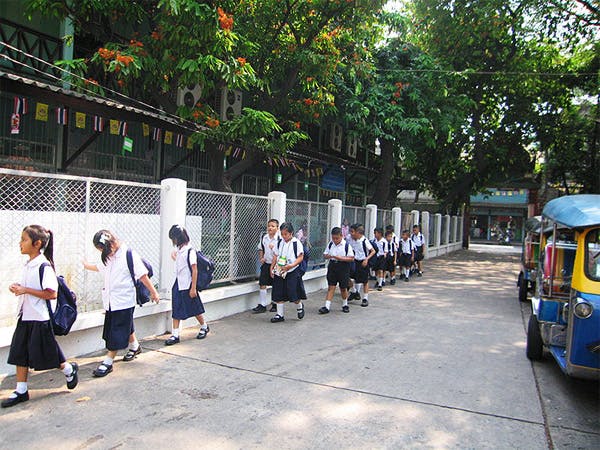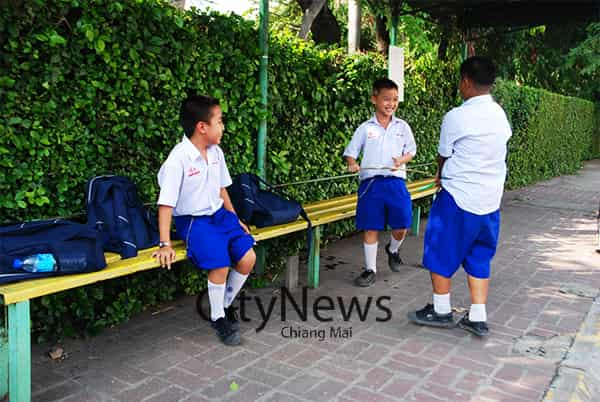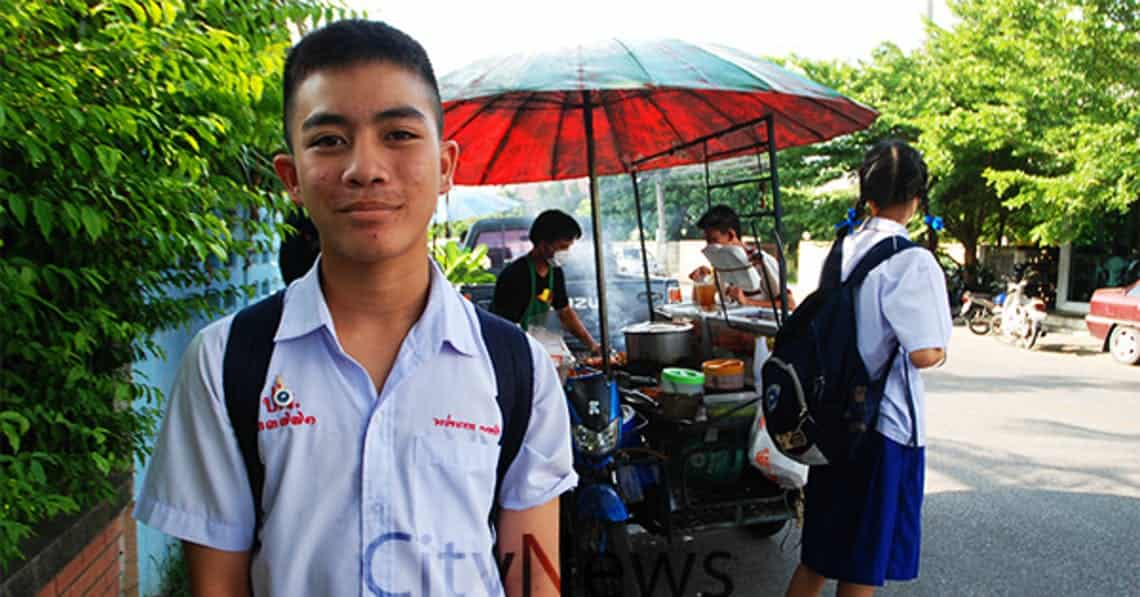Looking ‘natural’ or identical?
A couple of weeks ago I spoke to a Thai girl of fifteen years old who told me that after visiting a potential new school in Chiang Mai, she’d been informed, or, rather, barked at, that she must dye her (already natural looking) dark brown hair “a natural black”, and that she must also take out her (also natural looking) contact lenses.
At first I was shocked. I wondered why she chose to comply instead of simply looking elsewhere. After all, it wasn’t like she had bright pink hair and neon green eyes; maybe then there would be a real problem. In fact I couldn’t even tell that her hair, beforehand, was dyed, or that she even wore contact lenses.
But then I was told that “all schools in Thailand have these rules”.
After looking into it, I realised that the school uniform requirements here in Thailand are much stricter than they look on the surface. Perhaps the most extreme rule of all, as the American media brought to light last month, is the hair rule. Most female students must have hair only down to their neckline (many schools actually measure it… with an actual ruler) and male students must have military-like cropped hair.
Why enforce these rules?
It’s thought they originate from Thai government regulations in 1972, a period heavily saturated with intense military influence. Many schools still follow the outdated rules, and Thailand is still one of only four counties in the world where university students still have to wear uniform.
Free thinking students
The New York Times published an article last month suggesting that dress code in Thai schools is a part of a dictatorship rubric within the classroom, whereby students are taught only to obey and not to think for themselves. It included the story of a boy named Nethiwit Chotpatpaisan, nicknamed Frank, who began a Facebook campaign against the strict rules and monotonous curriculum in schools, gathering the support of over 10,000 other students.
The page, named “Confederation of Revolutionary Students for Thailand’s education system”, states that it only wants to “cause changes in a better way”, and bears the logo, “Education must begin with students and end up with students” across the title photograph, and “Give us rights” across the profile picture. The founder of the page Frank even appeared on national TV in January, and has found an unlikely ally in the Education Minister Phongthep Thepkanjana, who already promised to loosen rules regarding students’ hair earlier this year.
I contacted Frank through his Facebook page and asked him how he thought student behaviour would be affected if uniform rules were relaxed, to which he replied that it would allow, “critical and creative thinking”, something which is mostly restricted within Thai schools at the moment.
But the problem with the education system is much deeper than strict appearance. As well as having to dress the same, Thai students are taught to think the same; they are taught to think only what they are told, and not to question anything. The significant lack of self-reflective thinking means that students are, as school boy Frank puts it, “manufactured” by the government.
I asked him why he thought students were not encouraged to show individuality, and he said that Thailand is “really a military state”, adding that “teachers think that students are crazy, jokers, and they are alienated,” when they express, or attempt to express, individuality within the classroom. He also said that, in his opinion, “uniform [should be] cancelled”.

Different generations
I spoke to a Thai mother in Chiang Mai about her opinion on such strict uniform rules for students, and she told me, “students should enjoy wearing uniforms as it is special for them and no one else. There should be a couple of days a week when they can wear their own clothes though, to be different.”
I asked her whether she thought the way the students dress affected behaviour. “No. I don’t think having the same uniform makes them think the same. But children should be made to look the same, when they’re older [it’s] okay, they can do and wear what they want but not [as] children. I think girls should be able to have long hair but I think dyed hair [does] not look good; it [does] not look good for their school.”
She told me that she’d enjoyed wearing uniform during her school days. “The uniform doesn’t make the students feel regimented because they have their own uniform, different to the army. You cannot wear it again after you’re a student.”
Perhaps, having been brought up having orders drilled into their heads and wearing their way through a string of different uniforms, Thai adults cannot always relate to the free thinking students of today. But as ideology from the West seeps into the East, the new voices of students cannot be ignored.
Of course, uniforms can’t be completely abolished. We see workers on the streets of Chiang Mai every single day wearing a range of different uniforms. They have become a part of the culture and tradition. But so has the idea of regimentation; the idea that those wearing the uniform serve those above them. So has the idea using of strict discipline in schools to preserve the face of the establishment, and to discourage students and the public from asking questions.
Curriculum and schools
And the teaching itself is arguably laughable. Students are made to remember lists of names, dates and events that they will never need to know in the future, particularly with modern day internet inventions floating about. According to the New York Times, scores in national exams have been dwindling over the past few years, with students becoming less able – or, rather, less interested – in memorising what their teachers drearily chant at them.
Frank told me that the curriculum needed to be revolutionised and reordered, and according to The New York Times, the Education Minister, to an extent, agrees, but claims that the curriculum would take an extensive amount of time to be revised, and even then it would have to pass a number of public hearings before being put into action.
Some changes have already taken place. In March this year, school hours were cut down to 800 hours per year; 200 hours less than before. But, although this new rule had to be adhered to by schools in accordance with UNESCO recommendations, it doesn’t necessarily mean any new rules regarding uniform will be implemented.
Schools currently have the choice to implement whatever rules they wish, and head teachers of schools can also choose to ignore Government regulations regarding uniform, as the deputy head master of Frank’s school has suggested he may.
“Losing face”
But slackening the rules on uniform may just be what is needed to open the gateway to free thinking for students in schools. Presently students do not even ask questions during classes, for fear of “losing face”; if a student in a Western school asks the teacher they are praised for using critical thinking, but if a student in a Thai school asks a question then they risk making either themselves look “stupid” in front of the rest of the class for not understanding, or they risk making the teacher look bad, for not making them understand.
“Losing face” is another part of Thai culture that stands in the way of academic development. Thai schools want to look good, so they subject their students to strict, identical uniforms. Thai teachers fear being asked questions, due to loss of face, and students struggled on their own instead of asking for help, not wanting to lose face in front of other students.
It also means that things could take an extremely long time to change. If schools were, for example, to attenuate rules regarding uniforms, then it is likely that Thai families would not send their children there for fear of losing face in front of other Thai families. Appearance is everything in Thailand; even more important than children’s educations. Children are encouraged not to express individuality, because it is not the norm in Thailand and would, of course, mean loss of face of one family in front of another.
Money changing hands
Some schools use their uniform rules as a cover for something completely different. One man told me about his step daughter’s experience when she moved schools in Chiang Mai earlier this year.
“She had to take a test to get into her new school, so she took the test, and the school told us she hadn’t got a place. They didn’t give us the score, just said she didn’t get in. So she took the test again. Again, she didn’t get in, but they didn’t tell us the score. My wife went down to the school with my daughter, and they found out that she’d passed the test. They said they couldn’t let her into the school because her hair was too long and her fingernails were too long.”
It would seem, at first, that the school was more concerned about appearance than actual test results. But the man’s story grew worse.
“It turned out that, for 50,000 baht, they could allow my daughter into the school. It had all turned out to be a bribe. My wife managed to get the figure down to 20,000 baht in the end. My daughter still had to cut her hair.”
Schools even use appearance as an excuse to ask for money, and families will pay so as not to lose face. So why would schools change their dress codes? How else would they exploit families of potential students? This together with the fear of a generation of free thinking students will surely mean that schools won’t implement new regulations. Surely they will try and keep everything the same – as they have done for many years – for many years to come; a state of dictatorship and control in the classroom that reflects life beyond the school walls.

